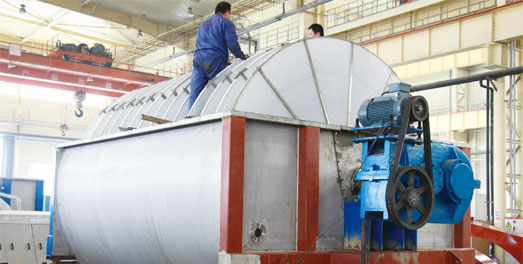Multi-disc Vacuum Filter
Multi-disc vacuum filter is a new-generation pulping equipment. It is mainly used for white liquor recovery and pulp refining. It can save energy and water consumption, lower fiber loss, protect environment and avoid pollution.
AGICO disc filter can manufacture pulp density and processing capacity according to technical requirements from the customer. AGICO owns mature technology and newest design software. Our products have occupied the majority market share in China.


Disc filter series and specifications:
| Disc QTY | ZNH25 | ZNH35 | ZNH45 | ZNH44 |
|---|---|---|---|---|
| Overall dimension L*W*H(mm) | Overall dimension L*W*H(mm) | Overall dimension L*W*H(mm) | Overall dimension L*W*H(mm) | |
| 4 | 3885*3035*4168 | |||
| 6 | 4485*3035*4168 | |||
| 8 | 5085*3035*4168 | 5510*4100*5361 | 6319*5450*6060 | |
| 10 | 5685*3035*4168 | 6210*4100*5361 | 7019*5450*6060 | 7415*6400*7235 |
| 12 | 6285*3035*4168 | 6910*4100*5361 | 7719*5450*6060 | 8115*6400*7235 |
| 14 | 6885*3035*4168 | 7610*4100*5361 | 8419*5450*6060 | 8815*6400*7235 |
| 16 | 8310*4100*5361 | 9119*5450*6060 | 9515*6400*7235 | |
| 18 | 9010*4100*5361 | 9819*5450*6060 | 10215*6400*7235 | |
| 20 | 10915*6400*7235 | |||
| 22 | 11615*6400*7235 | |||
| 24 | 12315*6400*7235 |
| Item | ZNH25 | ZNH35 | ZNH45 | ZNH55 |
|---|---|---|---|---|
| Model | ||||
| Disc Dia. (mm) | 2500 | 3500 | 4500 | 5500 |
| Per-disc filtration area (m2) | 8.5 | 16.7 | 26 | 38 |
| Capacity | 0.6-3M3/m3.h (white water recovery) 0.7-1.5t/m3.d (pulp thickened) | |||
| Fiber recovery rate (%) | >95 | |||
| Filtrate clarity(mg/L) | 20-80 | |||
| Inlet consistency (%) | 0.2-0.6(white water recovery) 0.5-1.2 (Pulp thickened) | |||
| Outlet consistency (%) | 4-6(white water recovery) 4-15 (Pulp thickened) | |||
| MOC | SS304 material for parts in contact with product | |||
| Vacuum degree (Mpa) | 0.02-0.06 | |||
| Net washing water pressure (Mpa) | 0.7 | |||
| Stripping water pressure (Mpa) | 0.7 | |||
Working principle
White liquor enters the multi-disc filter through the feeding box and distributes evenly in the tank. By gravity action, the pulp layer (2-3mm) will be formed on the fan. To ensure the best dewatering operation, the filtrate will be discharged to the corresponding channel at the central axis through the fan equipped with open grille.
The rotary shaft is linked with a filtrate valve that can switch on or off relevant vacuum channel. Vacuum is formed by atmospheric water loss. When it enters the valve, the filtrate will be classified into turbid filtrate, clear filtrate and ultra clear filtrate.
When the fan emerges from the suspension, the filtrate is expelled out, and the pulp layer is dehydrated under vacuum state. The pulp will be stripped off from the fan by spraying pipe, which is set into the discharge channel in the tank side by side, and then sent to the screw conveyor. The filter screen will be washed clean by the vibration pipe before the next cycle begins.
Advantages
In the process of white liquor recovery, water recycle is realized and water consumption is reduced. The fiber recovery rate is high, and waste and pollution are eliminated when white liquor is discharged. When the pulp is thickened, the pulp concentration is high, reaching 10%.-14%.
The filter plate has the features of diversified structure, economical application, high strength, convenient displacement, large effective filtration area and good filtration effect. The model and specification of equipment is complete, a client can select his product according to different requirements. Due to special wear-resistant material distribution plate, the filter has good sealing effect. The filter also has high automation and reliable performance with compact structure, small occupied area and large production capacity, so it gets easy to operate, bringing us good economic and social benefits.

